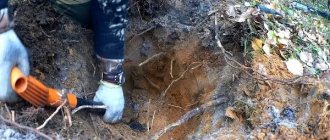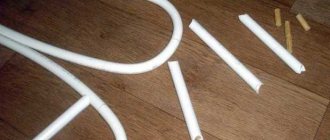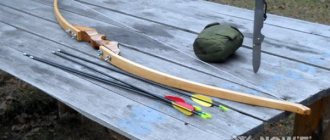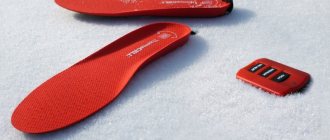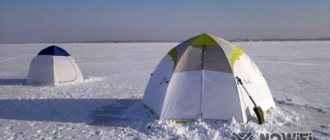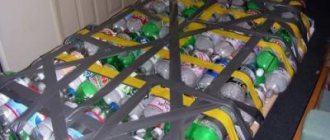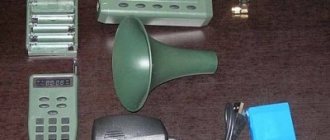Regardless of the conditions, place of permanent residence and possible threats, each survivalist arranges in advance hidden places for storing emergency supplies, or simply hiding places. Previously, on the pages of our website we have already described the conditions and stages of creating shelters in case of emergencies, now it’s time to talk about “control shelters”.
In special situations, it is not always possible to immediately leave your place of residence. Therefore, it is advisable to make a cache with everything necessary for autonomous survival, and not just one. The location of the cache should be outside the city in the direction of the shelter, since it is this direction, pre-selected taking into account various factors, that can be considered the safest.
If PD comes on suddenly and you don't have time to get home or pack a survival kit, your stash should have everything you need to survive for a couple of weeks. So, we create hiding places, and you can make one with maximum placement and a couple of distracting ones. In the first case, the cache will be capital; in the second, you don’t have to try too hard. If you are intercepted on the way, you can always give one “weak” cache in order to save the main one (according to the author of www.extreme-voyage.ru).
If your main emergency shelter is several tens of kilometers away, then there should be more than one cache. It is best to make such caches every 10-15 km, placing food and other consumables there. And then, even if you get attacked by marauders halfway through the journey, you will not be left alone with the unknown.
How to choose a hiding place
The cache should be located away from roads and trails, including animal trails to watering places. You should also make sure that you are not visible from the cache location. In this case, it can be easily installed and subsequently removed without the risk of revealing the secret place. Also take care of long-term storage of the cache. To do this, you need to find out about the plans for construction, arrangement, and laying of communications in the laying area.
The cache should be located in such a way that, if necessary, you can easily find it yourself, or tell someone about its location. For example, you are wounded and cannot walk, but your brother is not wounded - you should be able to tell him about the cache, which contains food and medicine that can save you.
Choose landmarks created by nature as pointers. For example, “at the top of the hill north of the peak of the rock.” Do not trust electronics and communications - during an emergency they can become useless! At least, the author of www.extreme-voyage.ru least of all counts on them in the event of an Apocalypse or large-scale military and man-made disaster.
What is a cache in DayZ and what is it for?
The game allows you to hide small things that contain something. After burying this object, only a small pile of dirt remains, which you won’t even notice in the grass unless you know exactly where to look. Nychki are needed for storing supplies “just in case”, or for single players. It will be especially useful to make one near your main place of residence and put all the most important things there. In this case, if you are robbed, you will not be left with nothing.
How to build a cache
The cache should be located below the freezing point in winter. This indicator varies in different regions, on average the point is at a depth of 50 - 150 cm. In case you dig out a cache in winter, hide some kind of hoe nearby. I think there is no need to explain why this is needed for people who have completed at least primary education at school.
The best option is to dig some kind of plastic container with a wide lid into the ground. If there is none:
• Carefully remove the top layer of soil with grass. • Digging a square hole. • Pour the extracted soil onto the spread polyethylene. • We install inside a frame made of thick branches or thin logs, on which the same logs will be laid on top in the form of flooring.
The flooring is needed so that a random person does not fall into the hole, and so that the cache inside remains intact for many years.
If you use a plastic barrel, moisture may form in it due to temperature changes. Therefore, all food and other accessories must be dried, wiped with alcohol and dried again. The supply of water and other liquids should be packaged separately and with special care.
Rules for organizing a cache
You have already seen that organizing hiding places and caches is an important component of any hike.
There are several rules for their organization:
- Containers and packaging of food and fuel The best containers for food and liquid fuel are plastic bottles and cans. Whatever you can, pour it in and pour it there. Obviously, the container must be clean and free from the smell of food, so as not to attract the main hunters - wild animals. Pack the bottles in plastic bags or cling film. Everything else can be put in thick plastic bags and containers. Be diligent. Poorly packaged food will be eaten by animals, leaving you at risk of running out of food in the middle of your trip.
- Place of hiding place Carefully choose the place where you will hide food and things. Choose a place that is mostly in the shade. Check to see if it is flooded. Equipment should not be left in low-lying areas or in the floodplain due to the risk of flooding. If the cache is organized in the forest, find a landmark: a large stone or a noticeable tree. Things are often placed in tree roots and covered with stones. When traveling through mountainous areas, a kurumnik can serve as an ideal place to lay it. Save the drop-off coordinates in a GPS navigator. If you do not have a GPS navigator, then the article: “Tourist GPS navigator for a hike in the forest” will help you decide on its choice.
- Food separately from equipment Be sure to hide food separately from equipment and fuel. The fact is that if the animals get to the food storage, they will not spare the equipment either. Rodents can easily chew through hidden ropes and ruin clothes.
- Note Another prerequisite for organizing a hiding place is leaving a note. It indicates: for whom the cache is organized, the date when the group will pick up the products, and also a request not to touch the things. The note is written in case someone else finds the drop first. Perhaps, after reading the message, the finder realizes that the lives of other people depend on the supplies left behind. The finder should not perceive the found treasure as a gift of fate; it is better to leave it in place.
How to prepare crackers so that you can store them for a long time, read here: “Preparing crackers for a hike: tips and recipes.”
What to put in the stash
We have written more than once about what to put in the cache. In short, the emergency reserve in the cache should contain:
• Medicines and medical supplies. • Stock of vitamins and shelf-stable products. • Drinking water, filter or water purification products. • NAZ. • Weapons (cold weapons, if possible firearms, properly prepared and packaged for long-term storage). • Clothes for all seasons of the year. • Individual protection means. • Communication equipment, flashlight, spare batteries. • Paper maps of the area.
Choose the rest according to opportunity, necessity and personal preference.
This is definitely not a hiding place
There are a lot of obvious places that have been widely known for a long time. The burglars examine them first. If you are wondering how to make a hiding place, make sure that your hiding place is not one of the ones listed below.
- Drawers of tables, chests of drawers, furniture walls, pianos, secretaries and the like. This is too obvious; even a child can easily discover such a stash.
- Among linen, both clean and dirty. You shouldn’t hope that a thief will disdain to turn over a basket of bad-smelling socks.
- In pockets and behind the lining of an old coat or jacket. Values there are also easy to find.
- In old and new videotapes, magazines and books. An upside down library is a classic attribute of every heist.
- Under the mattress or inside. It's funny, but many people (and not only older people) continue to keep their savings there.
- Behind mirrors, wall and floor carpets and behind paintings. Believe me, it will take you much more time to secure the “shovanka” there than it will take a thief to discover it.
- In the toilet cistern. This is another classic example of a hiding place. Rest assured, the thief will definitely look there.
- In the freezer, oven, jars of cereal, sugar or jam. You can find valuables there with one movement of your hand.
- Mezzanine. For some reason, people think this is the perfect place to store their stash. There's so much trash there. The problem is that a thief will not carefully go through the contents of the mezzanines. He will simply dump everything at once and very quickly find what is hidden.
- Video, audio equipment, other household appliances. If the item is worthwhile, there is a risk that it will be taken away along with the cache, and if it is old, the thief will have a question as to why the junk has not been thrown away yet.
- Under parquet or behind wallpaper. If the thief is in a hurry, it may work, but if they start tapping on the walls, then...
How to hide a cache
Despite the chosen deserted place, the constructed cache with the emergency reserve must be immediately disguised. Otherwise, according to the fundamental Law of Meanness, a mushroom picker, tourist or hunter will definitely wander in here immediately after you leave. That's why:
• Carefully cover the flooring of the cache with soil and polyethylene (this is described above). • We lay the previously removed top layer of soil with grass and roots. • We pour last year’s leaves, pine needles, dry branches on top - we do everything so that this place does not differ from the surrounding area. • We use strong substances around that discourage dogs from searching in this place. For example, we scatter tobacco or mix it with leaves. • If there are still flaws in the camouflage, we move back 10-15 meters and set up a small quarry, making it as visible as possible, then we dig a hole. This is a red herring. But it’s better not to do this and initially carry out the operation of laying the cache carefully and competently.
Now all that remains is to return unnoticed.
By your appearance, all random passers-by on the paths should understand that you are a mushroom picker, a tourist or a hunter, but not a survivalist who decided to cheat death and survive during hostilities or the Apocalypse. Source: www.extreme-voyage.ru OUR FACEBOOK PAGE: WE ARE VKONTAKTE:
The most unusual hiding places
First of all, think about how to make the hiding place secure, find a place where the thief will not even think about rummaging. Here are a couple of examples:
- in old shoes - one or two large bills can be tucked under the insole of worn shoes and placed along with all the shoes; the main thing is that the shoes do not look like outright junk - this may arouse suspicion; It is also important not to forget that money is hidden in shoes or sneakers, otherwise you may accidentally throw away your own stash;
- in a woman's pad - here the fact of disgust comes into play; most often a man, on pain of death, will not touch feminine hygiene products; Moreover, it would not occur to him to gut every gasket he found; if you hide the money inside one of them and carefully seal it again, then most likely your stash will remain untouched; again, it would be good not to forget that there is something there;
- in a tube of toothpaste, a bottle of shampoo, a bottle of deodorant; almost any case can be equipped with a double bottom and it will be no different from its own kind; the main thing is to place them where they will not look ridiculous; for example, a bottle of shower gel will look weird on a dresser or bar.
Chairs
The idea of treasures hidden in chairs appealed to many people after watching the famous film “The Twelve Chairs,” based on the novel of the same name by I. Ilf and E. Petrov. Interestingly, the plot of the work is also based on a real story. After watching the movie, it became clear to many that valuable things can be hidden in an ordinary chair. It is not at all necessary to put money or gold jewelry into the upholstery of this piece of furniture; you can create a secluded place that is more interesting. The seat of the chair needs to be made folding and attached with hinges. A bottom cut from plywood or wood in accordance with the size of the piece of furniture is nailed to the bottom of the side sides of the chair. You can hide any valuables in the resulting cavity between the bottom and the seat of the chair. But it is worth noting that such a hiding place is unlikely to be classified as reliable, especially if there are small children in the house, they will quickly declassify the mechanism of the chair.
4 1
